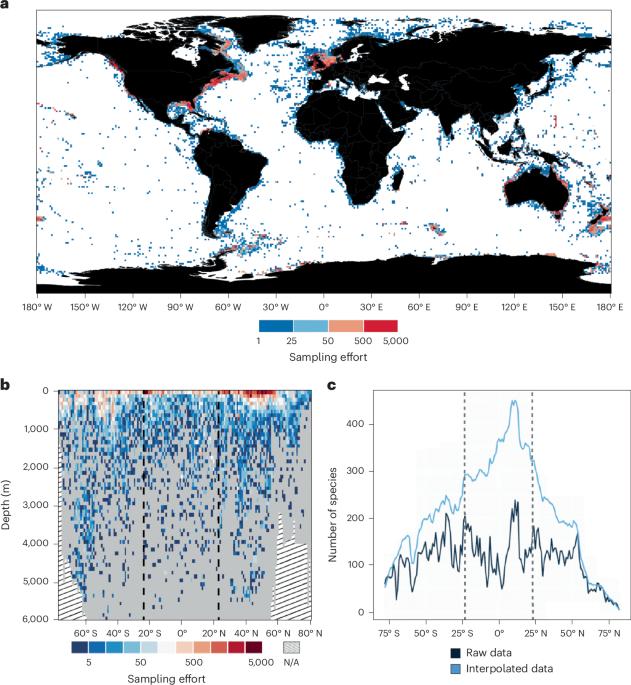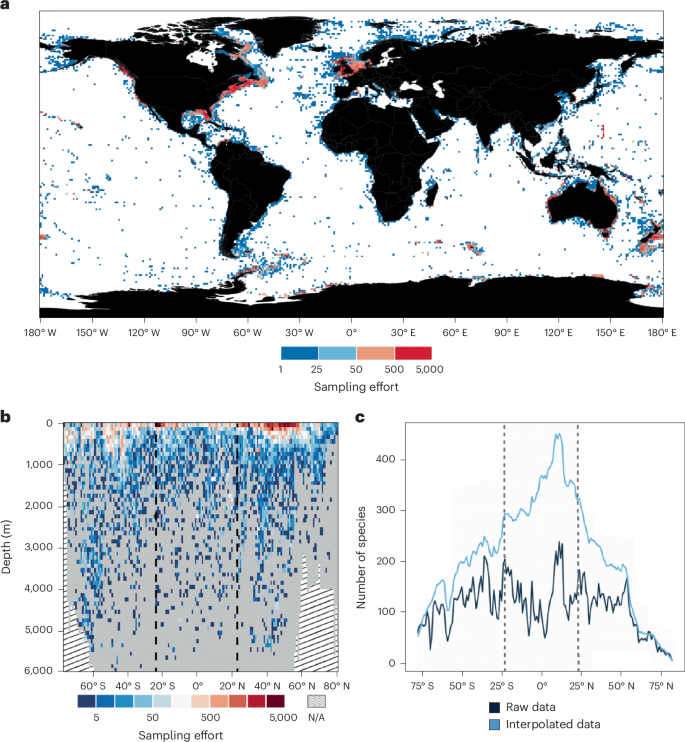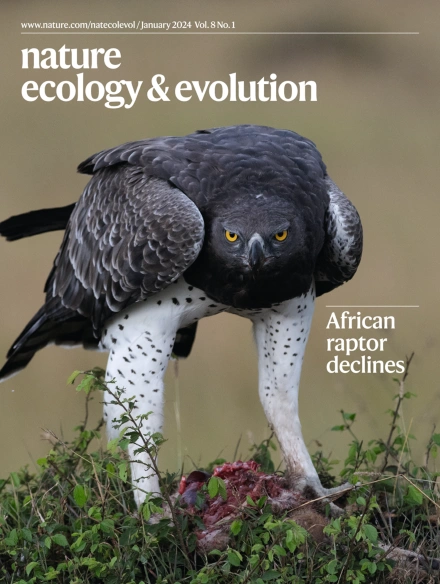Deep-sea-floor diversity in Asteroidea is shaped by competing processes across different latitudes and oceans
IF 13.9
1区 生物学
Q1 ECOLOGY
引用次数: 0
Abstract
The occurrence, shape and drivers of global distributional trends in species richness throughout the deep sea are poorly explored. Here we present a spatial description of the global, bathymetric and taxonomic extent of the benthic marine class Asteroidea using a compiled dataset of ~200,000 species-level occurrence records. We used these data to produce comparisons of sea-floor richness between hemispheres and oceans. We show that species richness is significantly correlated with temperature and nutrient flux despite markedly different distributional patterns across oceans and latitudes that suggest further influence from a combination of additional geographic, taxonomic and environmental factors. The relative importance of temperature and nutrient levels also varies greatly with depth. Species richness peaks in the shallow-water tropics, closely matching sea-floor temperature variation, but at bathyal and abyssal depths it is higher at temperate latitudes, where nutrient flux levels are of greater importance. We show that richness in the deep benthos is restricted below ~1.5 °C, with this strong thermal threshold consistent among oceans irrespective of other factors. Global trends in species richness in the deep sea are poorly explored. This study uses occurrence records of Asteroidea to show that species richness in the deep benthos is restricted below ~1.5 °C but correlated with temperature and nutrient flux, despite different patterns across oceans and latitudes.


Asteroidea的深海海底多样性是由跨越不同纬度和海洋的竞争过程形成的
对整个深海物种丰富度的全球分布趋势的发生、形态和驱动因素的探索很少。在此,我们利用汇编的约20万个物种发生记录的数据集,对底栖海洋类Asteroidea的全球、深度和分类范围进行了空间描述。我们使用这些数据来比较半球和海洋之间的海底丰富度。我们发现物种丰富度与温度和养分通量显著相关,尽管在海洋和纬度上的分布模式存在显著差异,这表明其他地理、分类和环境因素的组合进一步影响了物种丰富度。温度和营养水平的相对重要性也随深度的不同而有很大差异。物种丰富度在热带浅水地区达到峰值,与海底温度变化密切相关,但在深海和深海,物种丰富度在温带地区更高,那里的营养通量水平更为重要。我们发现,深海底栖生物的丰富度被限制在~1.5°C以下,无论其他因素如何,这种强烈的热阈值在海洋中都是一致的。
本文章由计算机程序翻译,如有差异,请以英文原文为准。
求助全文
约1分钟内获得全文
求助全文
来源期刊

Nature ecology & evolution
Agricultural and Biological Sciences-Ecology, Evolution, Behavior and Systematics
CiteScore
22.20
自引率
2.40%
发文量
282
期刊介绍:
Nature Ecology & Evolution is interested in the full spectrum of ecological and evolutionary biology, encompassing approaches at the molecular, organismal, population, community and ecosystem levels, as well as relevant parts of the social sciences. Nature Ecology & Evolution provides a place where all researchers and policymakers interested in all aspects of life's diversity can come together to learn about the most accomplished and significant advances in the field and to discuss topical issues. An online-only monthly journal, our broad scope ensures that the research published reaches the widest possible audience of scientists.
 求助内容:
求助内容: 应助结果提醒方式:
应助结果提醒方式:


